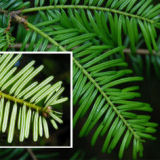 |
| Douglas fir |
Native Oregon trees
Douglas fir (Pseudotsuga menziesii)
The #2 Christmas tree in US, #1 in Oregon . Soft, thin needles.
 |
| Grand fir |
Grand
fir (Abies
Grandis) Flat needles. Great aroma and good needle retention.
 |
| Noble fir |
Noble fir (Abies Procera) Stiff
branches with upturned needles. Nice form. Good needle retention.
Non-natives
 |
| Nordman fir |
Nordman fir (Abies Nordmanniana)
Native to S. Europe . A good tree for people
with allergies. Good needle retention.
 |
| Fraser fir |
Fraser fir (Abies fraseri) Native to
 |
| Scots pine |
Scots pine (Pinus sylvestris) Native to Europe .
The #1 Christmas tree in the US .
Great needle retention and scent.
For a tour of these and other Christmas trees at Portland's Hoyt Arboretum, see Christmas Trees at Hoyt Arboretum.
A Brief History of
Christmas Trees
Early Europeans used evergreen boughs to decorate their homes at the
winter solstice.
1500s Christmas trees decorated in the town square in the capital ofLatvia
1500s Christmas trees decorated in the town square in the capital of
1600s Trees commonly decorated with apples in Germany
1700s Edible ornaments
on trees in Germany France
1800s Christmas trees introduced in US by German
settlers.
1846 Queen Victoria and family sketched sitting
around a Christmas tree, leading to its popularity in England
1851 First Christmas trees sold in US at a market
in NY.
1853 First Christmas tree at the White House.
1882 First electric lights on a Christmas tree by
Edward Johnson, protege of Thomas Edison.
1890s Glass ornaments arrive in US from Germany
1901 First Christmas tree farm in US.
____________